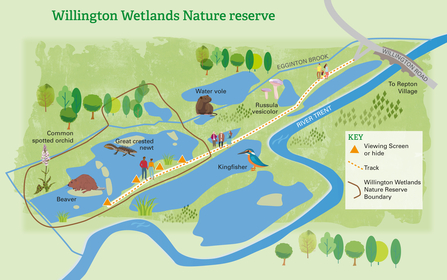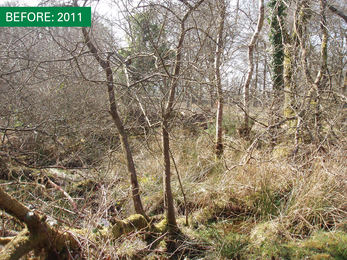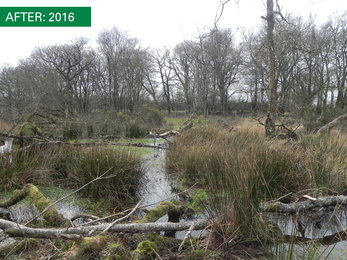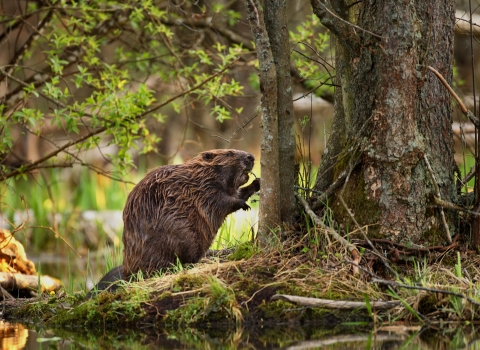David Parkyn
We've brought beavers back to Derbyshire!
Beavers have returned!
Take a peek at our map below for more information about Willington, and how beavers are helping transform the landscape!
Why have we brought back beavers?
This isn't just about the reintroduction of a species - it's about the reintroduction of an entire ecosystem that has been lost.
After 800 years, beavers are back in Derbyshire! Our beaver families will play a really big part in making Willington wilder. They enjoy over 40 hectares of wetland habitat, within a special beaver-proof fence. Egginton Brook flows through the beaver zone, and the native plants and trees offer our beavers all the food variety they need to thrive.
Willington Beaver Updates
First Beaver Release Day 27/09/21
This was the day our first beaver pair were released into Willington Wetlands.
Second Beaver Release 07/10/21
Drone footage from our second beaver release day, we now have four beavers at Willington Wetlands.
Beavers Settling In October 2021
The beavers have been familiarising themselves with their new habitat, our camera traps picked up this fantastic footage of the beavers searching about on land.
Our Iconic Species November 2021
It has been fantastic to see beavers alongside our iconic species at Willington Wetlands via our camera traps.
Second Beaver Release Day video 2021
Beaver kits in Derbyshire July 2022
Willington Wetlands just got a dam lot cuter!
Two kits (baby beavers) have been born in Derbyshire for the first time in 800 years thanks to successful beaver reintroduction programme.
During the months running up to the kits sighting, staff and volunteers at Derbyshire Wildlife Trust observed the beavers settling down in a lodge (a beaver’s family home made from sticks and mud), grooming one another and caching extra food, which were all positive signs of them being a well-established pair.
Volunteers at the reserve have now managed to captured the new kits on film. These little balls of fluff cannot yet dive for themselves, so for now their parents have to literally jump on them to help them get under the water due to the buoyancy of their fur!
Take a peek at the footage above!
Beaver kits August 2022
Take a look at the latest footage we have of our beautiful beaver kits as they explore their new home - We've spotted them swimming around at Willington Wetlands!
Notice how the bodies of the kits are much higher in the water due to their natural buoyancy! This can make it hard for them to dive initially, though this video shows them learning to dive quite nicely. The close, playful interactions between all the family members is wonderful to witness!
Thinking about visiting our Willington Wetlands Nature Reserve? Check out our map below and see what you might find at the reserve!

(c) Caroline Mummery
Beavers are known as nature's engineers. They make changes to their habitats which create diverse wetlands for other species to thrive.
What do the beavers do on site?
Beavers are a special species that can play a particularly crucial role. As they go about their day to day life shaping the wetlands for their own benefit, they have a huge impact on the surrounding areas. By digging canal systems and damming water courses, they create diverse wetland areas and homes for other animals such as otters, water voles and water shrews.
Want to know more? Our Head of Nature Recovery Networks, Matt Buckler and Living Landscapes Officer, Henry Richards have more information for us about beavers below!
Where do the beavers come from?
Our first set of beavers came from the River Tay in Scotland. The second set came from a temporary reserve in Devon.
There are two species of beaver; the European/Eurasian (Castor Fiber) and the Canadian/North American (Castor Canadensis). The European beaver was native to Britain so this is the species we have re-introduced.
What happens if they escape?
Don't worry! They will stay near their families and we’re trained in re-capturing them so we will be able to rescue them quickly. The fence will be checked by our staff daily to make sure there is no damage.
The beaver fencing that is being installed is to an exact specification from Natural England that has been agreed following a full site survey with the anticipated flood risk and levels appropriately considered, making sure we keep the beavers safe and that they don't escape.
All pedestrian and stock gates are designed to an approved beaver proof specification.
What do they eat?
Contrary to what many people believe, beavers only eat plants! Not just trees but they’ll be eating brambles and other plants too. They’re big fans of Himalayan balsam, which is an invasive non-native species that can spread easily and become problematic for our native wildflowers.
Will we lose our trees and will they build dams?
No, they don’t kill trees, they coppice them. These grow back and provide more spaces for wildlife. Beavers are often known as eco-engineers, they are only doing what our team of rangers would be doing on our wetland reserves to provide the best habitat for wildlife, but they will be doing it far better than we can!
We are not sure if they will build dams but it is a possibility. Beavers build dams to create lagoons in which they can better protect themselves from predators and in which they often build their family lodges which are accessed from underwater. The ideal depth of water a beaver seems to seek behind these dams is around 70cm (28”). The average depth of Willington isn’t far off this so beavers initially may feel no need to dam. In fact in other areas of the world such as Telemark in Norway where studies have been carried out, no damming activity has taken place at all in similar circumstances. They could of course choose to create new lagoons by damming Egginton Brook but this is by no means a given.
Do they need a home to start with?
Yes, we’ll have to make them a temporary lodge, but they’ll build their own pretty quickly.
This is costing thousands of pounds per beaver – what are the benefits and will they have adverse effects on the wading birds?
Beaver create a mosaic of habitats, from small and large ponds, canals, vegetated margins, wet meadows and areas of mud and silt trapped behind dams. They are ecosystem engineers, and experts in wetland management, creating more diverse habitat for inhabitants, from the smallest invertebrates to large mammals.
We want to show people how great beavers are for wildlife, habitats and us humans as well. Our dream is that soon beavers will be allowed to live wild across the country, as they are in most of Europe, and we won’t need to fence them in.
Adopt a beaver
Money raised goes to local wildlife conservation work, such as managing nature reserves or creating new habitats for these animals.
Success Stories
We aren't the first Trust to be getting back on board with beavers!
Devon Wildlife Trust
As ecosystem engineers, beavers are able to quickly make a positive impact on the landscape they occupy.
These before and after images taken from a fixed-point post in the enclosed beaver project run by Devon Wildlife Trust, show the impact the beaver activity has had on the capacity of the land to hold water in just five years.
This example of landscape engineering ‘slows the flow’ of water, thereby decreasing the chance of flooding downstream.







